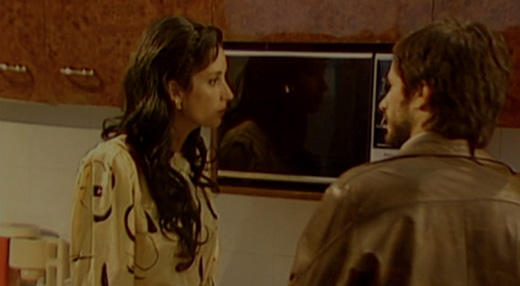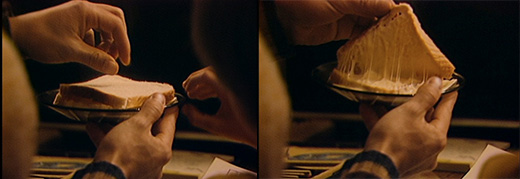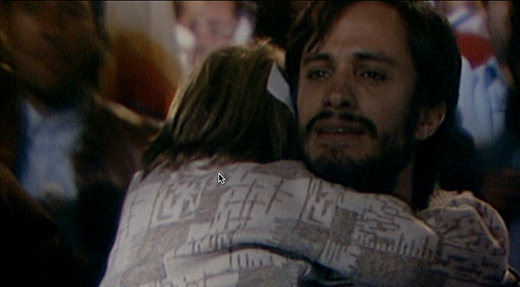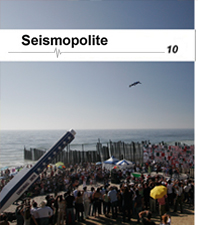April 30, 2015
Pablo Larraín’s No and the Aesthetics of Television
Written by Fabrizio Cilento

Pablo Larraín’s No (2012) is a Janus-faced film, documentation and interpretation. The movie reconstructs the events surrounding the 1988 Chilean referendum through the perspective of the fictional René Saavedra, an advertising executive hired to run a television campaign to end General Augusto Pinochet’s rule.[1] Larraín’s use of video technology from the period (outdated U-matic 3:4) gives the impression that the events were recorded as they occurred. The result is what I refer to as “fictionalized documentary,” that is, a film that blends archival television documents with staged scenes that reconstruct the real events in such a way that the end result appears to be a reportage.
A movie made by combining contemporary technologies with existing analogue footage from the campaign (circa 30% of the film) would have resulted in an uneven style. Thus, to give his work a creative unity, Larraín produces an “ideal documentary-like footage” that gives the film a layer of verisimilitude and reflects the visual culture at the time of this historical turning point for his country. As the director declared, “it breaks my illusion when I’m looking at a film that is shot in high resolution and they cut to archival footage that is made in video or old resolution film stock. We were able to create the illusion in a way that fiction became documentary and documentary became fiction” (Wilkinson, 3). Larraín’s visual reproduction of the era’s aesthetics is so persuasive that on first sight it is difficult to distinguish which scenes were shot in the new millennium. He adopts techniques such as highly charged colors, soft lighting, and an abundant use of close-ups and medium shots.[2] The titular capitalized letters “NO” appear out of focus in the opening sequence, as well as the intertitles that display the historical facts: “In 1973 Chile’s armed forces staged a coup against President Salvador Allende and General Augusto Pinochet took control of the government. After 15 years of dictatorship, Pinochet faced increasing international pressure to legitimize his regime” (FIG. 1-2). The whole project is consistent with this blurred attitude, since magnetic video does not reproduce extreme light and dark contrasts efficiently, but easily breaches into whiteness. Larraín is fascinated by the expressive quality of this involuntary effect, which he uses to externalize the ambiguous inner motivations of his characters. In turn, this is a reflection of the ambiguity of the period in which they lived. This is a strong signal that the film has taken as its primary task, to work with the material and develop it from within, rather than a straightforward interpretation of the archival footage.

Fig. 1-2.
The osmotic relationship between fiction and documentary reveals how the images shot for the plebiscite and those that Saavedra produces for commercial purposes are inextricably linked. For this reason, the metafictional sequences are pivotal to understanding the film, since in them the protagonist processes his own created television work for us, using the exact same sentence to pitch three very different ad campaigns: “What you are going to see now is in line with the current social context. After all, today, Chile thinks about its future.” He uses this slogan in the opening sequence in order to sell a Free Cola commercial, later to persuade the members of the opposition to approve his anti-Pinochet campaign based on an imaginary idea of happiness, and, at the end of the film, to endorse a The Bold and the Beautiful type soap opera, with a clip of models posing on top of a skyscraper while a helicopter approaches. As one can evince from this brief description, the structure of the film is symmetrical (beginning and ending with corporate promotional images), with Saavedra’s mantra about Chile’s future functioning as a narrative frame that somehow detonates the revolutionary political narrative at the center of the film, suggesting instead a provocative continuity between the military period and the aggressive waves of neoliberalism that followed it.[3] Thus, the repetition of the same sentence in the film has a conceptual as well as a structural value.
In the No campaign, idealism, rebellion and commerce brilliantly coexisted. Social engagement appears as advertisement, but advertisement is also a form of social engagement. And the result is vertiginous. Larraín chooses to deliberately rearrange chosen facts and is animated by the impulse of representing the liminal moment in which Chilean opposition embraced a polished communication style typical of First World capitalism, which, historically, had worked as an instrument of oppression for the local population. As Benson-Allott wrote, by doing so “Larraín creates an aesthetic appropriate for critiquing the removal of Pinochet through the same shallow capitalist principles he helped introduce to Chile” (61).
Rather than focusing on the social injustices perpetrated by the regime, in launching the No campaign Saavedra and his team emphasized the possibilities offered by an eventual democratic shift. They embraced the rhetoric of happiness, exemplified by the opening song “Chile, joy is coming” (“I want a jingle,” Saavedra says, “no art, no folk, no pop, no rock”), and a rainbow logo, that symbolizes the different currents within the left working in harmony. After that, there were the No-ticias, a brief rubric of talking head interviews with the opposition leaders or people who were voting No, and a compilation of advertisements linked together in a fifteen-minute program. The No campaigners made the best out of their limited amount of time and introduced an aesthetic of short, fast paced editing onto the Chilean small screen. They couched the spots in a tradition of familiar gags and characters - thus the entertaining images appeared as a moment of lightness amid the uninterrupted tedium of the daily propaganda.
Despite regulation by a powerful system of internal censorship and despite its apparent innocuous simplicity, the No campaign recycled television language itself, drama, avant-garde graphics, animation, didactic documentary, and even high modernist films, and in doing so became one of the most successful programs on television. A liberating laugh and a confident gaze to the future served to destroy the negative image Pinochet had created of an incompetent and violent opposition and at the same time to demystify Pinochet’s aura of invulnerability through irreverence and caustic sarcasm.
The overall playfulness of the campaign created a generational fracture in the Franja de propaganda electoral, the organized opposition that had been set up by the government in order to donate legitimacy to the plebiscite in the eyes of the international community. Saavedra’s campaign largely uses cinematic effects, and the photography, music, and editing are both sophisticated and ostentatious. However, the price to pay for catching the mass audience’s attention was to leave off screen some of the principles that had historically animated the resistance to Pinochet. Crucial issues such as poverty, health, repression, delinquency, housing, exile, and torture were only addressed indirectly via musical, humorous sketches and approached with caution and symbolism (Hirmas, 90). This choice was controversial. Older members did not think that the government would allow an eventual victory to stand, thus they conceived the campaign solely as an instrument of political denunciation. The brief access to national media was an opportunity to recognize those who had been tortured or disappeared under the regime. Having watched a demo of some more “realistic” advertisements created under the supervision of the militant members, Saavedra stands by the screen and comments on the uselessness and inadequacy of their strategy. He neutralizes their approach by casually stating that to him democracy seems fun, and that he was very much moved by the images, but a campaign based on social injustice would simply not “sell.” The advertising language becomes a Trojan horse to infiltrate into the regime, and the strategy to sell democracy as a happy product in the end becomes a way to surpass a right wing government on the right, beating it at its own game. Saavedra implies that short ads based on the immediacy of the documentary form and a phenomenological approach to reality echoing the legendary The Battle of Chile (Patricio Guzman, 1975-1979) would not be sufficient to gain more votes. He is aware that, this time, the battle is not fought with guns (or cameras used as weapons of denunciation), but at the level of the popular imaginary, shaped by television. However, in the end the democracy advocated by the campaign becomes the democracy of consumption, moving toward the American-style patterns of advertisements and the perverse and wickedly funny melodrama of prime time soap operas (Dargis, 3).
Saavedra goes through this anguishing dilemma in his own private life as well. It is important to consider these parallel narratives together in order to fully understand No. Although the film does not provide a clear background, there is a sense that his marital crisis was generated by the same conflict between being gracefully committed vs. being radically committed in order to overthrow the regime. A fierce and radical opponent of Pinochet, his wife Verónica is beaten and arrested by the military twice during the film. On the contrary, after being exiled to Mexico, Saavedra returns to his country and is reintegrated as an executive, working side by side with powerful corporations and high administrative functionaries. Although Verónica is still attracted to her husband, there is a sense that she is not fully able to deal with his choice to abandon his ideology to work within the system, and to compromise, even when their aim is to achieve the same end result. As a consequence, the two only meet occasionally in the interest of their young son.
Additionally, we see that the now successful Saavedra, after committing himself to the campaign, is simultaneously working on a promotion for a microwave oven, a domestic appliance whose boxy look and black screen is very similar to that of a television. The set for the commercial is a well-designed kitchen in which a model/housekeeper engages in clean and painless cooking (FIG. 3).

Fig. 3.
Saavedra is fascinated by this new frontier in domestic technology, and he brings one to his own house, no longer able to differentiate his workplace (the TV studios) from his rationalized home. He prepares dinner for his son commenting on how the microwave can heat food quickly and efficiently (FIG. 4-5). Both a microwave and a television work with electromagnetic radiations. One causes polarized molecules in the food to rotate and build up thermal energy, with allegedly detrimental effects on the nutrients in food. Similarly, the waves of the campaign sent by television affect our nervous system and our psychological reception of political messages. They elegantly remove radical politics and give the opposition a new, “thawed,” pre-packaged imaginary. Furthermore, the microwave represents a symptom of an acceleration of everyday life (the need to limit the time dedicated to cooking in order to increase productivity at work), the corporate world’s rhythms and philosophy taking on the anachronistic idea of a quiet domesticity. This pervasiveness of the US lifestyle in home interiors can only happen with the simultaneous removal of militarism and the implicit rejection of socialism (the Allende past), whose ideological apparatus suddenly appears as a dusty archaism that has no place in Chile’s modern identity, based on the free circulation of tech-based products that can heat up food in the time it takes to watch a TV ad.

Fig. 4-5
Forged in this setting, the No campaign is pivotal and, in its own way, masterful because in targeting the undecided (mostly women and young people), it defined voters’ problems, aspirations, and expectations, reconciling past and future within the endless present of televisual “real time.” The regime menaces Saavedra multiple times but does not operate in the old fashioned way, of torturing and/or kidnapping him, because in the end a figure like him is functional to the new economy. There is a need to provide new generations access to free communication, ‘clean up’ all the satellite dishes and increasingly transform all of TV broadcasting to let Chileans know about the new kind of life that they ‘must’ live with absolute, peremptory clarity. Larraín’s film makes visible some dynamics that his country is ready to embrace after decades of oppression that are invisible to the naked eye (again, this is why we see a bifocal perspective of the letters “NO” and the historical facts at the very beginning of the film). Thus, in the end, it is not surprising that the majority of the leaders choose to follow the idea of a soft campaign, reducing the ideological content and sociopolitical issues, and instead addressing them indirectly through a polished aesthetic.
The Yes campaign had an equal amount of air time, but also, as Saavedra puts it, “the rest of the day.” Pinochet learned how to use the new media for his own profit, engaging in televised press conferences and seducing a vast number of spectators by looking straight into the camera. His popularity often conforms to the right-wing stereotype of the incarnation of military efficiency and the quintessence of patriotic courage. In his messages, he reminds those who accuse him of being Fascist that he is constricted to use full police power above the law with the objective of stopping the terrorist network. Pinochet informs inquiring journalists that if people insist upon keeping Chile free from socialism, then the public opinion must accept the necessary consequences. What emerges is the style of a military commander, more concerned with results than with formal hierarchies. The most obvious subtext of Pinochet’s speech is the notion that the Chilean colonels are somehow more masculine than their civilian counterparts and those liberal journalists and intellectuals who challenge their political opinions. Virility is visually conveyed by the parades, in which the physical health of Pinochet is exalted through his larger than life uniform that emphasizes his shoulders. He often appears surrounded by kids, which humanizes him and at the same time associates him with the idea of fatherhood. Pinochet, who makes every effort to break the conventional war type of the mad/sadist colonel in front of the camera, nonetheless appears determined to defeat his enemies, no matter what methods may be necessary. Immediately following Pinochet’s image , however, Larraín cuts to the horrifying reality of the regime with several scenes of repression and arrest. This abrupt juxtaposition gives an idea of his dialectical method of illustrating the events. The riot scenes, in which Saavedra is beaten and his wife is arrested again, emphasize the moral condemnation of dictatorship.
Toward the end of the film, Saavedra demonstrates a certain lack of passion for his country’s future and does not join the cheering crowds in the streets of Santiago to celebrate the unprecedented victory to which he contributed much. On the contrary, he remains impassible and detached. This is a sign of the increasing disillusionment of the protagonist for his work and of his awareness of the sociopolitical vacuum he helped to create. He is carrying his son, who just wants to nap on his shoulder, a sign that Saavedra failed to transmit a sense of civil engagement to the future generations (FIG. 6). Through the use of a catchy tune and upbeat humor, the No campaign won, but its promises were based on a generic concept of happiness that had no equivalent in reality. For him, to join the crowd would mean to celebrate the moment in which political activism turned into marketing, approaching a pacific, non-violent revolution as just another visual artifact.

Fig. 6
The major critical controversy of the film No regards its alleged impartiality: although not a recreation of reality but rather a reflection on its causes, there is a great ambiguity in the film between what is presented as being based on historical evidence and what is ideology masked by the appearance of objectivity. No has been criticized by those who adopt the ‘myth’ of historical accuracy as a judgment criterion. In their opinion, Larraín does not furnish a reconstruction of the role and the nature of the opposition, or a politically or sociologically adequate representation of Chilean campaigners,[4] instead it creates a fictional, heroic outsider.[5] While these critiques underline a possibly inevitable superficiality of Larraín’s analysis, their demand for a rigid adherence to factual detail misunderstands the film’s fictionalized documentary approach. Obviously, even the most rigorous documentary form would involve the inevitable subjective criteria of representation and a point of view, but furthermore part of the value of No is in its ability to catalyze a larger historical discussion on the democratization process and to raise greater questions about the possibility for relations between Chile and North America that are not based on fear, cultural imperialism, and racial discrimination.
The movie’s thematic core has surpassed not only the contingent Chilean situation the film describes, but also the traditionally defined “political” categories of right/left, private/public, absolutism/democracy to which critics have in some way confined the movie. Through the long hours spent interviewing activists and the Chilean population, the director was able to capture the spirit of the No campaign on screen. Through his dedication to creating a work that appeared as a documentary and gave the impression of the truth, he was in fact able to capture some of those elements that, while they did not appear as essential in the interpretation of the time, in retrospect continue to gain new significance.
Fabrizio Cilento is Assistant Professor of Film & Digital Media at Messiah College (PA). He received his Ph.D. in Comparative Literature (Film Studies Program) from the University of Washington in 2010, and has contributed to journals such as Fast Capitalism, The Arizona Journal of Hispanic, Cultural Studies, California Italian Studies, and Teorijia in praksa.
Bibliography
Benson-Allott, Caetlin. “An Illusion Appropriate to the Conditions: No (Pablo Larraín, 2012).” Film Quarterly, 66.3 (Spring 2013), 61-63. Print.
Dargis, Manohla. "Try Freedom: Less Filling! Tastes Great! ‘No,’ With Gael García Bernal." The New York Times. The New York Times, 15 Feb. 2013. Web. 29 Jan. 2015. <http%3A%2F%2Fwww.nytimes.com%2F2013%2F02%2F15%2Fmovies%2Fno-with-gael-garcia-bernal.html%3Fpagewanted%3Dall%26_r%3D1%26>.
Hirmas, María Eugenia. “The Chilean Case: Television in the 1988 Plebiscite.” Television, Politics, and the Transition to Democracy in Latin America. Ed. Thomas E. Skidmore. Baltimore: Johns Hopkins University Press, 1993, 83-96. Print.
Khazan, Olga. "4 Things the Movie 'NO' Left Out About Real-Life Chile." The Atlantic.
Atlantic Media Company, 29 Mar. 2013. Web. 04 Apr. 2015. <http://www.theatlantic.com/international/archive/2013/03/4-things-the-movie-no-left-out-about-real-life-chile/274491/>.
Rohter, Larry. "One Prism on the Undoing of Pinochet: Oscar-Nominated ‘No’ Stirring Debate in Chile." The New York Times. The New York Times, 09 Feb. 2013. Web. 30 Jan. 2015. <http://www.nytimes.com/2013/02/10/movies/oscar-nominated-no-stirring-debate-in-chile.html?pagewanted=all>.
Wilkinson, Amber.‘‘Man in the No.’’ Eye for Film. Eye For Film, 8 Feb. 2013. Web. 04 Apr. 2015. <http://www.eyeforfilm.co.uk/feature/2013-02-07-pablo-larrain-talks-about-his-oscar-nominated-film-no-feature-story-by-amber-wilkinson>.
[1]By voting Yes one would endorse Pinochet’s presidency for eight more years, while a No supported holding democratic elections within one year. The political opposition to the regime won, with 54.7% voting No.
[2]Larraín began his career by making television advertisements and in 2011 directed the TV series Prófugos, distributed by HBO Latin America. Both experiences were crucial when it comes to the capacity of managing archival material and the awareness about the logics of television he displays in No.
[3]At the beginning of the film, Saavedra’s boss, Lucho Guzmán, is affiliated with the Pinochet regime and strongly disapproves of him collaborating on the No campaign. He then reports Saavedra’s activities to his supervisors, who engage in harassment and intimidation such as vandalistic acts and intrusion in the protagonist’s home. However, after the plebiscite, we still see Saavedra and Guzmán working together within the democratic regime on the promotion of the already mentioned soap opera.
[4]In particular, Genaro Arriagada, director of the No campaign, said: “The film is a gross
oversimplification that has nothing to do with reality. The idea that, after fifteen years of dictatorship in a politically sophisticated country with strong union and student movements, solid political parties and an active human rights movement, all of a sudden this Mexican advertising guy arrives on his skateboard and says, ‘Gentlemen, this is what you have to do,’ that is a caricature” (Rohter, 2). Similarly, Francisco Vidal, a cabinet minister in two recent Socialist governments, wrote on his Twitter account: “To believe that Pinochet lost the plebiscite because of a TV logo and jingle is not to grasp anything of what occurred.” Arriagada also discussed the discrepancy between the real life events and the movie with Olga Khazan at The Atlantic.
[5]No is a loose adaptation of The Plebiscite, an Antonio Skármeta play. This is where the fictional character of Saavedra was originally conceived, blending together the characteristics of two different real-life campaigners.











